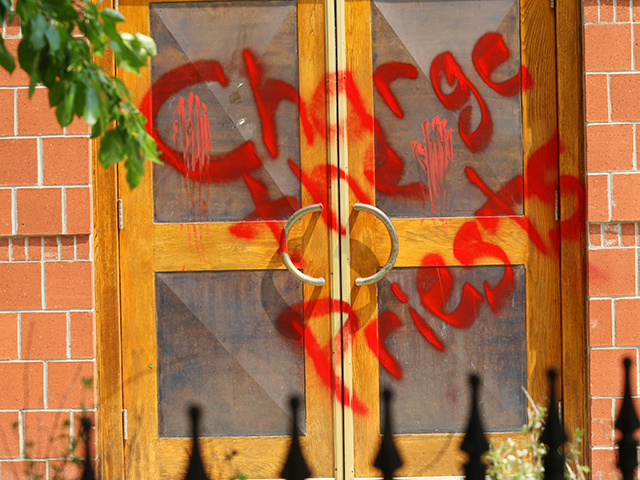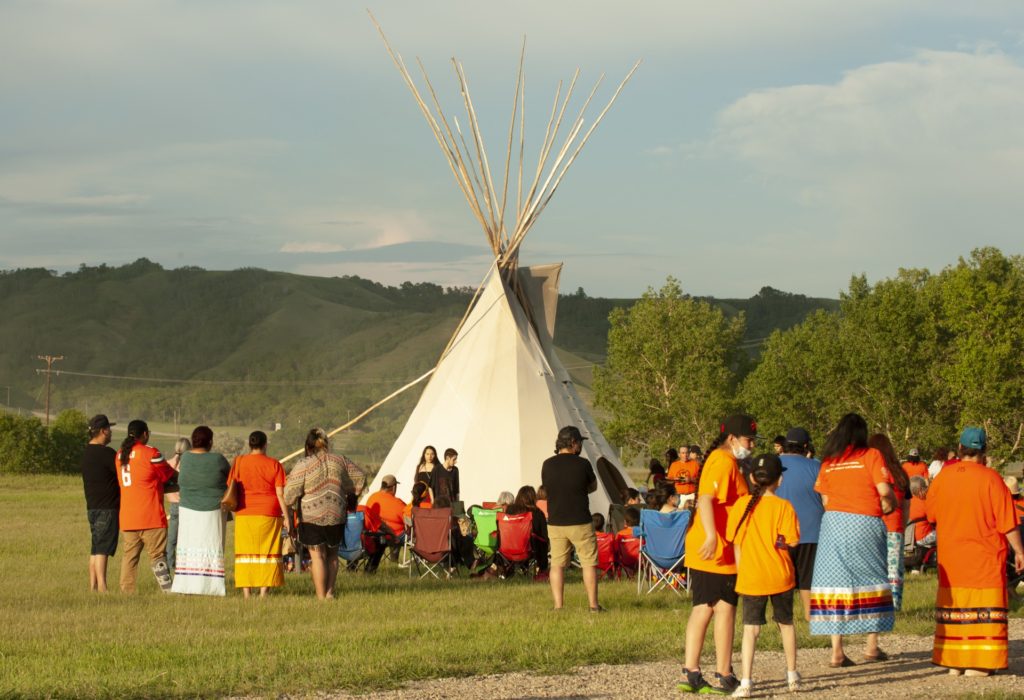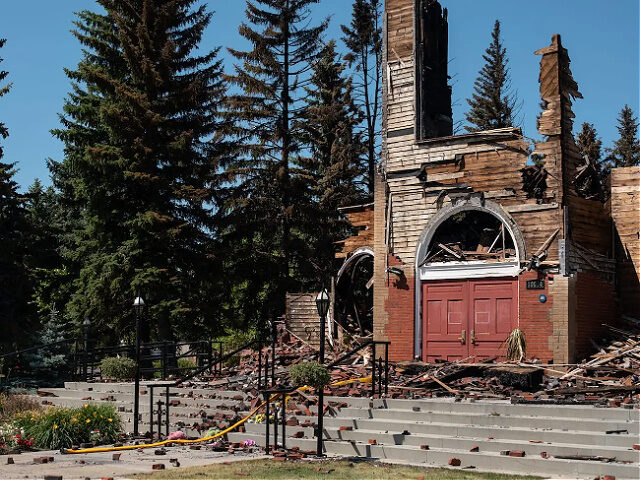Canada’s National Post noted on Wednesday that church arsons “never stopped,” with at least six new church fires reported in the past two months, but the media gives them little coverage and rarely discusses the debunked reports of mass graves at a Christian boarding school for indigenous children that touched off a wave of church burnings in the spring of 2021.
The National Post produced its in-depth look at church arsons after the most recent incidents, the shockingly brazen attack on the Blessed Sacrament Parish in the city of Regina, Saskatchewan, on February 9 and the complete destruction of the Chilcotin Log Church in Williams Lake, British Columbia, later on the same day.
The Blessed Sacrament Church is a historic structure, among the oldest Roman Catholic churches in the province. Fire crews discovered the back door of the church on fire early on the morning of February 9. Security camera footage showed a masked man dousing the door with gasoline, setting it on fire, and fleeing on foot.

Paint covers the walls at Saint Bonaventure Catholic Church on July 03, 2021, in Calgary, Canada. Calgary police are investigating after at least 11 city churches were vandalized. The acts of vandalism appear to be the latest in a series of recent protests against the church’s historic involvement in Canada’s residential school system. (Dave Chidley/Anadolu Agency via Getty Images)
“I saw it all moments after it took place, by smart cam, and I was shocked. Then I saw on other cameras in the house, I could see the smoke coming in, so I was very, very disturbed. Later, when I saw the video, I was even more disturbed,” Pastor James Hentges told CBC News.
Hentges said the church recently installed fire detectors that quickly alerted firefighters to the blaze. He said the security camera footage made the attack seem premeditated and was “frightened” and “shocked” that anyone would try to set the church ablaze.
“We’ve had other acts like graffiti on the church or our dumpster being lit on fire. But those are not quite as shocking as this,” the pastor told Global News on Monday.
The fire was contained before it could damage much of the Blessed Sacrament Church beyond the door and its frame. The Chilcotin Log Church was not so fortunate. A fire broke out in the early morning hours of February 10 and completely consumed the archaic wooden building.
The log church was a historic structure and a beloved community landmark. Condolences to longtime pastor Art Joyce and his congregation poured in from across the region, including from Tl’etinqox Chief Joe Alphonse.
The Royal Canadian Mounted Police (RCMP) are investigating the burning of the Chilcotin Log Church as an arson attack, possibly linked to the crime spree perpetrated over the weekend of February 10 by a man who made death threats to neighborhood residents, stole a Jeep, and rammed a police car while trying to escape. The suspect was tasered and taken into custody.
“Both are among more than half a dozen incidents of church arson in just the last two months, the continuation of a trend that has never really stopped since it began three years ago,” the National Post observed on Wednesday, tallying up 68 church burnings during the 2021 frenzy.
The church burnings began after tribal leaders in British Columbia claimed a radar survey had uncovered 215 mass graves beneath the ground where the Kamloops Indian Residential School once stood. Several other mass grave discoveries near the sites of other Catholic boarding schools were soon announced, bringing the total up to over 750.
The residential schools were likened to “concentration camps” by Bobby Cameron, head of the Federation of Sovereign Indigenous Nations in Saskatchewan. He said the mass graves were evidence that Canada tried to “exterminate” the First Nations and claimed the graves had to be discovered by ground-penetrating radar because the Catholic Church removed all the grave markers to conceal them.

A vigil takes place where ground-penetrating radar recorded hits of what were believed to be 751 unmarked graves near the grounds of the former Marieval Indian Residential School on the Cowessess First Nation, Saskatchewan, Saturday, June 26, 2021. (Mark Taylor/The Canadian Press via AP)
There was little doubt the residential school system subjected its forcibly incarcerated students to abuses, and many of them were killed, but the mass grave story ripped open old wounds and made the long-shuttered schools seem more hideous than ever.
Far-left Prime Minister Justin Trudeau condemned the mass grave discoveries as a “shameful reminder of the systemic racism, discrimination, and injustice that indigenous people have faced – and continue to face – in this country.”
When a retaliatory wave of church burnings and other vandalism swept across Canada, Trudeau said that, while arson is “unacceptable and wrong,” the anger motivating the perpetrators was “fully understandable given the shameful history that we are all becoming more and more aware of.”
As it turned out, the discoveries that Trudeau claimed made church burnings “understandable” were false. No actual mass graves were ever uncovered.

In this June 1, 2021, file photo, Canadian Prime Minister Justin Trudeau visits a memorial at the Eternal Flame on Parliament Hill in Ottawa that’s in recognition of discovery of alleged remains at the site of a former residential school in Kamloops, British Columbia. (Sean Kilpatrick/The Canadian Press via AP, File)
“The discoveries were global news in 2021, and the lack of archaeological confirmation has not gone unnoticed. A 2022 story in the New York Post dubbed the saga the ‘biggest fake news story in Canada.’ A recent full-page feature Kristeligt Dagblad even dubbed the event an incident of ‘mass hysteria,’” the National Post recalled. Kristeligt Dagblad is a Danish Christian newspaper.
The New York Post article from May 2022 noted there was a great deal of political fallout from the mass grave panic, along with some hefty price tags on government programs:
Within days, Prime Minister Justin Trudeau decreed, partly at the request of tribal leaders, that all flags on federal buildings fly at half-mast. The Canadian government and provincial authorities pledged about $320 million to fund more research and in December pledged another $40 billion involving First Nations child-welfare claim settlements that partially compensate some residential school attendees. Pope Francis issued a formal apology on behalf of the Catholic church, which ran many of the residential school facilities and asked for God’s forgiveness. He said he planned to visit Canada later this year to further assist in healing and reconciliation.
The story also gained a significant pop-culture footprint, as several television dramas alluded to the residential school horror or similar stories about comparably atrocious boarding schools for Indian children on American soil.
The ongoing burning of churches appears to be another lingering aftermath of the mass graves story. Canadian Conservative Party leader Pierre Poilievre extended condolences to the congregation of a church burned three days before Christmas, noting it was “the fourth church in two weeks to be targeted by acts of violent anti-Christian hatred,” and sending a clear signal that church burnings are on the Canadian opposition’s radar.
The National Post quoted Conservative lawmakers pointing out that most of the burned and vandalized churches have been located on First Nations land and served First Nations congregations, making them among the primary victims of the hate crimes.
The Toronto Sun noted in July 2021 that First Nations leaders were quicker to condemn the church burnings than the Trudeau administration, and they did so in much stronger terms, frankly denouncing the arsons as inexcusable crimes.

COMMENTS
Please let us know if you're having issues with commenting.